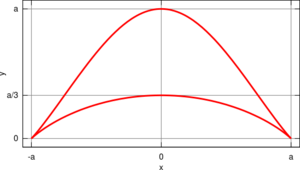Bicorn

In geometry, the bicorn, also known as a cocked hat curve due to its resemblance to a bicorne, is a rational quartic curve defined by the equation[1] It has two cusps and is symmetric about the y-axis.[2]
History
In 1864, James Joseph Sylvester studied the curve in connection with the classification of quintic equations; he named the curve a bicorn because it has two cusps. This curve was further studied by Arthur Cayley in 1867.[3]
Properties

The bicorn is a plane algebraic curve of degree four and genus zero. It has two cusp singularities in the real plane, and a double point in the complex projective plane at x=0, z=0. If we move x=0 and z=0 to the origin substituting and perform an imaginary rotation on x bu substituting ix/z for x and 1/z for y in the bicorn curve, we obtain This curve, a limaçon, has an ordinary double point at the origin, and two nodes in the complex plane, at x = ± i and z = 1.[4]
The parametric equations of a bicorn curve are and with .
See also
References
- ↑ Lawrence, J. Dennis (1972). A catalog of special plane curves. Dover Publications. pp. 147–149. ISBN 0-486-60288-5. https://archive.org/details/catalogofspecial00lawr/page/147.
- ↑ "Bicorn". mathcurve. http://www.mathcurve.com/courbes2d.gb/bicorne/bicorne.shtml.
- ↑ The Collected Mathematical Papers of James Joseph Sylvester. II. Cambridge: Cambridge University press. 1908. p. 468. https://archive.org/details/collectedmathem01sylvrich.
- ↑ "Bicorn". The MacTutor History of Mathematics. http://www-history.mcs.st-andrews.ac.uk/history/Curves/Bicorn.html.
External links
 |

